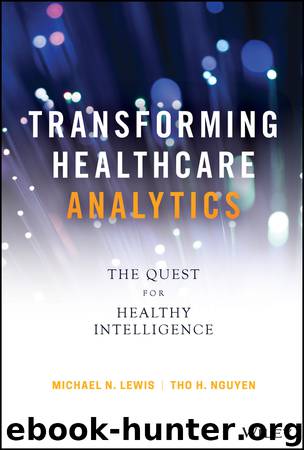Transforming Healthcare Analytics by Lewis Michael N.; Nguyen Tho H.; & Tho H. Nguyen

Author:Lewis, Michael N.; Nguyen, Tho H.; & Tho H. Nguyen [Lewis, Michael N. & Nguyen, Tho H.]
Language: eng
Format: epub
Publisher: John Wiley & Sons, Incorporated
Published: 2020-03-24T00:00:00+00:00
Need for Speed
In-memory processing is becoming the new or next-generation high-performance computing. Many vendors in this space have developed visually rich analytics features with click, drag-and-drop capabilities levering in-memory technology. With easy access to data and analytics, organizations are adopting in-memory processing to develop interactive health data dashboards and explore data without limits. There are a few vendors that offer in-memory for advanced analytics. With in-memory technology, healthcare organizations can now engage their data with blazing speed, resulting in more informed, proactive, insight-driven decisions.
Gartner Research1 confirms that not only can data be retrieved faster, but in-memory technology performs complex calculations and query results significantly faster than disk-based approaches. This allows users to dissect data and create robust reporting without the limitations associated with traditional business intelligence (BI) tools such as multidimensional cubes or aggregate tables. Near real-time, ad-hoc query capabilities can be extended to even high volume and velocity for healthcare organizations.
Organizations are adopting in-memory processing to solve many issues in conjunction with the traditional approach and seeing the need to improve performance, economics, and governance. The needs are very similar to in-database processing and become the main drivers for many organizations in healthcare and other sectors. Here are some reasons for in-memory analytics:
Complex Analytics Requirements
Traditional IT infrastructures present a number of challenges, and one of them is to overcome the slow query performance supporting complex analytical requirements. It simply cannot keep pace with today's changing and dynamic data management and analytical requirements for fast and accurate analysis. In addition, it is not designed to process complex analytics on terabytes (or beyond) of data efficiently. This is where in-memory processing can help. In-memory processing can solve complex analytics that are often coupled with large data volumes.
Growing Big Data Volumes
Many enterprises are being challenged by a massive explosion of data in their databases and analytics applications. Traditional data is being captured and stored, along with unstructured forms of data files such as emails, notes, images, and freeform text (such as tweets, clinician comments/status, and other social media sources). At the same time, tighter regulations under the Health Insurance Portability and Accountability Act (HIPAA) and the Food and Drug Agency put the burden on healthcare providers and organizations to maintain and store data available for years to come in case of audits or requests from law enforcement agencies. In-memory processing makes access and analysis of large data volumes possible at incredibly fast speed and yields a higher return on investment.
Less Reliance on IT
With the presence of digital transformation and the explosion of web-enabled applications, healthcare organizations are discovering it is becoming harder to manage their data and analytical projects. With the traditional approaches, the queries and reporting are taking too long to execute because it takes too long to manipulate the data. In-memory processing eliminates complicated disk-based shuffling of data. There will be no need to wait for the IT bottleneck to build summary and aggregated tables to be used for analysis from the disk-based data. Business units can be more self-serving with in-memory processing.
Download
This site does not store any files on its server. We only index and link to content provided by other sites. Please contact the content providers to delete copyright contents if any and email us, we'll remove relevant links or contents immediately.
Hit Refresh by Satya Nadella(8328)
The Compound Effect by Darren Hardy(7545)
Change Your Questions, Change Your Life by Marilee Adams(6636)
Nudge - Improving Decisions about Health, Wealth, and Happiness by Thaler Sunstein(6629)
The Black Swan by Nassim Nicholas Taleb(6182)
Daring Greatly by Brene Brown(5636)
Deep Work by Cal Newport(5452)
Principles: Life and Work by Ray Dalio(5315)
Rich Dad Poor Dad by Robert T. Kiyosaki(5140)
The Myth of the Strong Leader by Archie Brown(4785)
Man-made Catastrophes and Risk Information Concealment by Dmitry Chernov & Didier Sornette(4728)
Big Magic: Creative Living Beyond Fear by Elizabeth Gilbert(4717)
The Slight Edge by Jeff Olson(4716)
Discipline Equals Freedom by Jocko Willink(4631)
The Motivation Myth by Jeff Haden(4521)
Digital Minimalism by Cal Newport;(4511)
Stone's Rules by Roger Stone(4412)
Management Strategies for the Cloud Revolution: How Cloud Computing Is Transforming Business and Why You Can't Afford to Be Left Behind by Charles Babcock(4127)
The Doodle Revolution by Sunni Brown(4034)
